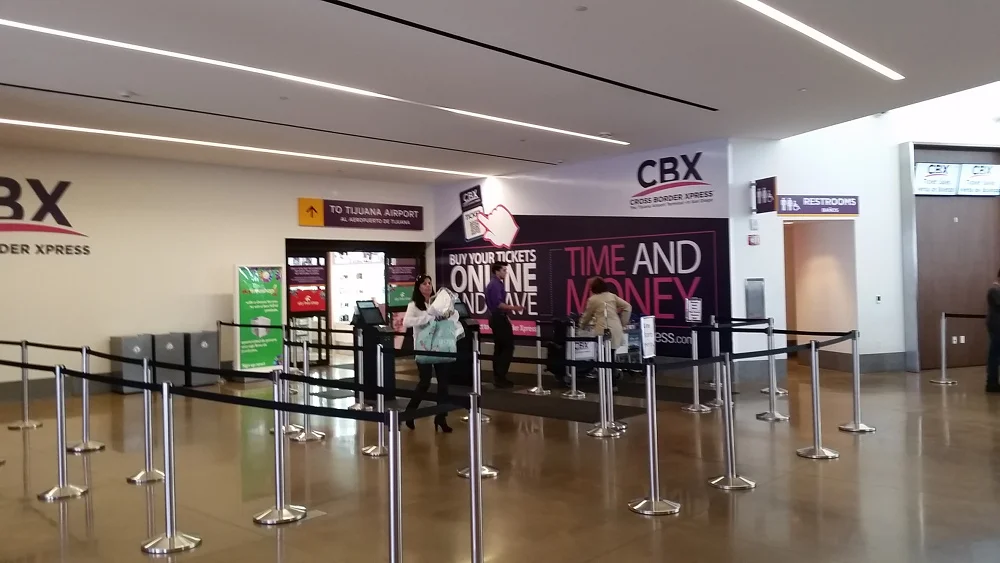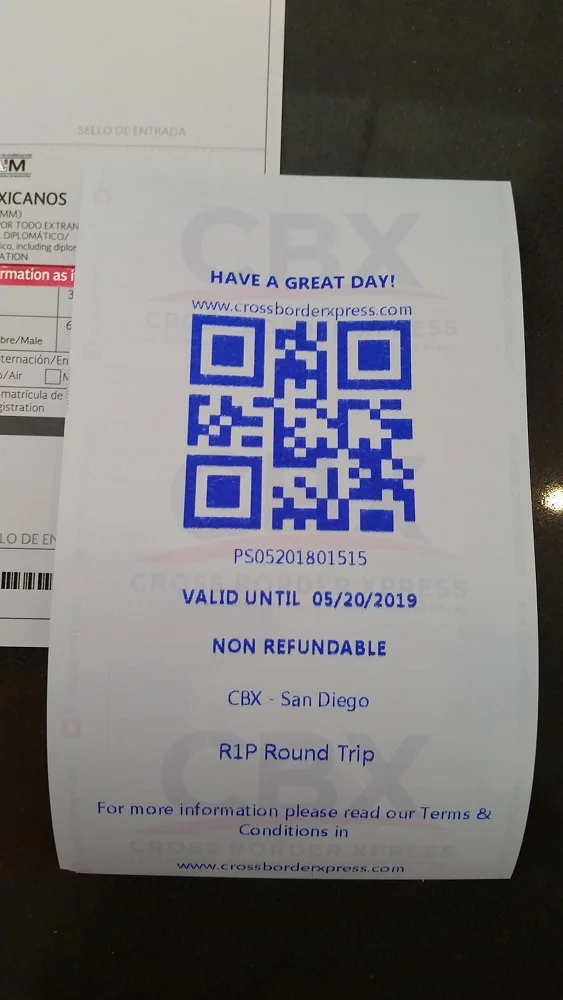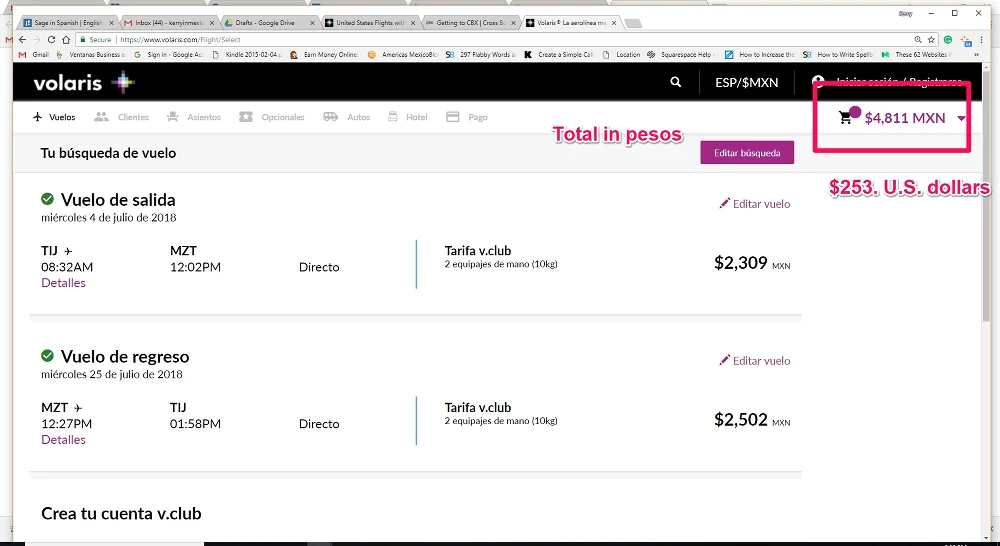A Complete Guide to San Diego’s Cross-Border Express [Video Included]
Updated October, 2023
The Cross-Border Express is the world's first truly binational airport terminal. While technically located in the United States, about a 20-minute drive south of San Diego, the CBX connects to the Tijuana airport just on the other side of the border by means of a land bridge. Its purpose is to allow an easier way to access Mexican domestic flights out of Tijuana.
Basically only Mexicans and Mexican-Americans use the CBX. I've got to admit, the process initially confused and intimidated me, which is probably why CBX is still so underutilized by American travelers, but it’s a terrific way to save money on flights within Mexico.
This is the entrance to the pedestrian walkway from the San Diego side of the Tijuana airport
The CBX Land Bridge
The entrance to CBX is in the United States, technically in Otay Mesa, about a $50 Uber ride south of San Diego. The CBX building on the California side even looks like an airport.
You enter the CBX building, buy a ticket, and walk an inside pedestrian bridge over the border directly into to the check-in area of the Tijuana airport. From there, you take what has just become a cheaper Mexican domestic flight rather than the international flight everyone else takes. I've included a video of my Uber ride so you can see the route and U.S.-side entrance.
This is a video of the drive to the Cross-Border Express in Uber from San Diego. The CBX is the world's first true binational airport passenger terminal. You enter the terminal on the U.S. side (Otay Mesa, south of San Diego) and take a pedestrian walkway directly into the Tijuana airport.
CBX terminal, U.S. side
Directions to the CBX
To get to the Cross-Border Express (CBX) from the San Diego airport by car, you take the Britanica exit off 905. You will see signs for CBX. Most people catch a shuttle or Uber.
CBX will come up on your Uber app without needing the address. Your Uber driver will be able to take you right to the CBX entrance (as you can see in the video).
Inside CBX Building
Once inside the CBX building, you buy your pass. You don’t check your baggage here, however, because you have not yet cleared customs.
To the left of the Volaris airline counter, you will see the CBX ticket counter. There you purchase either a one way ($15) or round-trip ($25) pass to use the bridge. Take a picture of the bar code. This will enable you to scan a picture should you lose your return ticket or if the ink gets worn off the ticket in Mexico’s humid coastal climates.
You will fill out your declaration form on this US side too right before entering the bridge. A counter with pens is set up for you to fill out the customs form.
The door to the bridge is to the left of the CBX sales counter, clearly marked. Free carts are available for your luggage if you need one for the longish walk.
Once you enter the CBX walkway, you will have a bewildering (yet bemusing) moment of Mexican commerce as you are forced to walk through the duty-free store before reaching the sliding glass doors to enter the main part of the pedestrian bridge, a 10-minute walkway that leads you to eerily tranquil customs kiosks.
After passing through the easiest, calmest customs and baggage screening areas you've experienced since 9/11, the bridge will lead you directly into the Tijuana airport terminal on the Mexico side. You enter the terminal right where you need to check your bags. The Mexican airline Volaris, which usually has the cheapest flights, is at the furthest end of the terminal from where you enter from the pedestrian bridge.
Consider the Tijuana V.I.P. Lounge
Like most people, you probably get nervous about being on time for international flights (but probably still not as nervous as my ex-boyfriends). If you are in the habit of giving yourself ample time to allow for missed exits, traffic jams and the like, you may have an hour or two to kill when everything goes smoothly.
Rather than waiting it out with the general population, purchase access to the V.I.P. Lounge for around $25 dollars when you purchase your Volaris ticket. Mexican airports don't offer as much seating as American ones do. V.I.P. lounges are handy for charging electronics and resting up.
To find the V.I.P. lounge in the Tijuana terminal, look for Carl's Jr. The entrance for the V.I.P. lounge is tucked in next to the Carl's Jr. entrance, then up a short escalator. Make sure to check your baggage before going to the V.I.P. lounge as they only allow carry-ons inside. You take an escalator up to the lounge, but can only exit by the stairs (Welcome to Mexico) which would make having a large suitcase a problem.
Taking a bus to your final destination
Volaris and other Mexican carriers fly to all the larger cities in Mexico. However, if you need to get to a smaller town in Mexico, you’ll to take a bus from the hub airport to that town. Touring buses in Mexico are extremely comfortable, quiet and sometimes provide refreshments. Its a good way to wind down from your flight. It's likely you won't have to wait long for a bus that goes to your destination.
For example, when I book a round trip ticket from Denver to Mazatlán using Mexican carriers out of Tijuana, I book a round-trip ticket from Denver to San Diego for about $150. Then I book a Volaris flight from Tijuana to Culiacan (the capital city of the state of Sinaloa where Mazatlán is located ) for about $240.
From Culiacan, I take the luxury bus to Mazatlán, a three hour ride. Buses leave Culican for Mazatlán every half hour. The bus trip costs about $10 dollars. This brings the total cost for the round-trip to $400 as opposed to over $650.
Using CBX is a great option if you want to break up your trip to Mexico over two days and spend the night in beautiful San Diego. You could follow the same basic plan if to fly from Tijuana to just about anywhere in Mexico.
Cost comparisons between flying to Mexico from Tijuana versus San Diego
Here are screenshot comparisons of the prices for flights from San Diego to Mazatlán on American carriers vs. the cost of flying from Tijuana to Mazatlán on Volaris with only two weeks lead time to purchase the ticket.
The costs flights to Mexico on Expedia, with two-weeks notice, on American carriers
My choice on Volaris for the same dates (in pesos and dollars) using CBX to access the Tijuana airport.
You can save additional money if you join Volaris frequent flyer program (Tarifa V.Club as you see above) for about $50. You need to book your flight online to get the cheapest fare.
Recommended hotel chain near airports in Mexico
Anytime you travel internationally, things can happen. Should you miss a flight or one gets canceled and you end up marooned in a Mexican city, knowing a good hotel comes in very handy.
During my last trip to Mazatlán, the apartment I had rented there still needed to be cleaned the day I'd planned to arrive. I decided to spend the night in a hotel in Culiacan and take the bus the next day.
City Express hotels are located near airports in 30 cities in Mexico are much like US business hotels near airports.
You can get a shuttle to their hotels at the airport from the same kiosk you use to pay for cabs. You probably won't be in the mood for adventure. You'll want it fast, clean, easy, safe and cheap. These hotels meet those requirements.
City Express hotels have excellent internet and cable, are immaculate, well-air-conditioned with a split in each room, and secure (you use your room key to access the elevator.) They provide a nice breakfast in the morning until 10:30, have English-speaking staff and even offer room service. Check-out is at a languid 1:00 p.m. The cost is about $50 or so a night, except in Mexico City ($92).
All cozy between the sheets in my cold room with a remote in one hand and a cheeseburger in the other, I almost didn't want to leave. A night in a neutral business hotel was the perfect tranquilizer after a day of passing through the cultural membrane.
Four major reasons why you should try the CBX (at least once).
1. If you don't have the lead time, months often, to get an economical rate on domestic American flights, you can get a reasonably priced Volaris flight with less than a week’s notice and clip quite a bit off the otherwise high cost of your trip.
2. San Diego is a beautiful, wonderful place to spend a day on your way to Mexico. I much prefer breaking up my trips Mexico over a two days. Even when the cost of a hotel in San Diego cancels out my savings on the flights, I much prefer doing the trip over two days and arriving to my destination in Mexico fresh and in the middle of the day.
3. The adventure of it. It’s a more authentic Mexican experience. You’re traveling a Mexican carrier. You get to practice your Spanish. You learn to navigate better in a foreign culture. They serve different snacks!
4. Familiarizing yourself with this process gives you additional choices and more experience in how to travel to and around Mexico.
The way I look at CBX and taking Volaris fights is that even if there’s a glitch and I have to pay for changing a flight or spend a night in a Mexican hotel, I still save a little money, plus I have a bit more of a Mexican Experience. Every Mexican Experience prepares you a little better for the next Mexican Experience.
Related links
Having a Mexican phone number comes in handy for a number of reasons. The $10 a month AT&T plan is a no-brainer - Ventanas Mexico
Surprising things you'll want to consider taking to Mexico - Ventanas Mexico
Next up:
Do you find yourself sighing some days? How would you describe them? Are they with satisfaction or ennui [blog]
About the Author:
Kerry Baker is the author of three books. "If Only I Had a Place," is your guide to renting well, long-term in Mexico. It's full of information about how to lay the infrastructure to get the most luxurious places for less, year after year.
Her second recent book is “The Mexico Solution: Saving your money, sanity, and quality of life through part-time life in Mexico. A blue print for having the best of both worlds along with anecdotes that make a cultural point.
Her most recent book is “The Lazy Expat: Healthy Recipes That Translate in Mexico” a cookbook for the traveler, snowbird and expat who wants to maintain a healthy diet in Mexico (spoiler: You must cook). More than 150 easy to prepare recipes you can make from the simplest of kitchens at home or in Mexico




